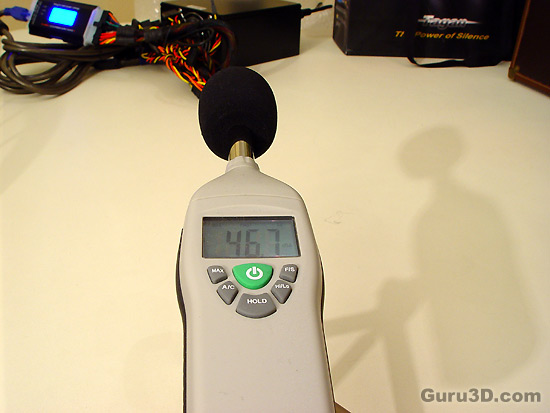Page 6
A real-world testing experience slash scenario
We have to settle for real-world experiences. We took an NFORCE 590 SLI reference mainboard and equipped it with Conroe dual-core E6600 processor and overclocked it towards 3.4 GHz to make sure we are using more powah !
Now we equip quad-sli (2x GeForce GX2 7950 GX2 1024 MB), 2 GB DDR2 memory @ 800 MHz, added a DVD-Writer and a HD.
We loaded up Quad SLI drivers, and enable a seriously funky gaming experience at a monitor resolution of 1920x1200 ( a good balance between hefty GPU usage whilst using the CPU at maximum as well). Pretty spiffy stuff huh ?
Now for the test we looped X3: the Reunion timedemo three times and monitor the behavior of the PSU with a wattage meter and mutli-meter. The wattage meter will tell us how much peak wattage we where able to pull from this PC and the power-meter will tell is how much voltage is boosted though the voltage rails.
Here's what we did during the timedemo:
-
For gamers with (Quad) SLI/Crossfire, the most power draw will be at the 12 volts rails. Tapping the 12volts rails separately with a multi-meter will show stability in Watts.
-
Now we tap the 12 volts (2) rail over the GeForce 7950 GX2 PCB when the Quad SLI setup is 100% at work and peaking. This was the maximum variation shown in the test and is flawlessly stable.
-
We look at the wattage meter and it's peak, the result was near 500 Watts. Not enough to really test this PSU.
LOW is the lowest measured value and HIGH of course the highest voltage peak we measured. A 5% fluctuation is perfectly acceptable, so 12 Volts should remain between 11.4 - 12.6v as you can see the PSU when stressed stays FAR from that.
So we took the primary voltages in both IDLE and LOAD (fully utilized) modes. We noted down the lowest and highest value we see and that is the fluctuation. If a PSU is unstable we'd see much fluctuation, differences and discrepancies which can result in system instability.
On each of the voltage rails, a 5% tolerance would be the accepted as normal and the ATX reference standard, meaning the power-supplies actual voltages should stay somewhere in-between the values.
There's no such thing present for the Tagan, thus thing is stable. Unfortunately with PSU's like these .. we can't stress them enough to see if they are really capable of pushing for example 4x 20 AMPs. We have to rely on what Tagan is writing on that box for now.
Now then, you've had a peek at the photo's, combined all factors, and now you should have a pretty broad idea of how this PSU would function for your current or future PC. Quite honestly, I did my best. In a 3D intensive test run with 100% utilization in an overclocked environment this kid is stable as can be, and remember this was tested on a NVIDIA Quad SLI system with an overclocked (+ 1000 MHz extra) E6600 Core 2 Duo processor.
Sound levels (dBA)
Here's where stuff is getting a little weird. Tagan is marketing this product as very silent. That however not the case at all as I think it's a really loud PSU.
Granted there is plenty of ventilation and the PSU will not get hot with a current high-end system. But Tagan is advertising the product at 26 dBA if the fans are at 100% rotational speed. We measured this in a silent room with a dBA meter. Mind you that the only thing activated and making noise in this room is the PSU. It's activated and that's pretty much it. The result was a unpleasant 46 DBa, not exactly the power of silence as noted on the packaging.
That's a lot for any PSU. Below you can see a photo of that test, whilst somewhat subjective this is as objective as we can measure. The meter is roughly 50-75 CM away from the PSU.

